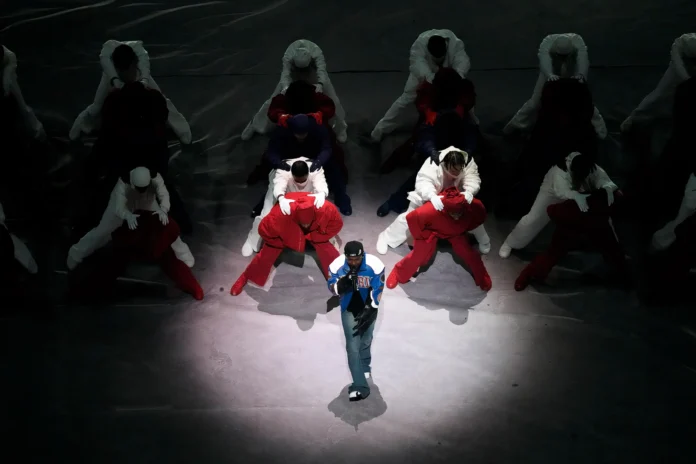
On Feb. 9, Kendrick Lamar delivered his long-awaited Super Bowl halftime show, performing in front of thousands of people in New Orleans and even more watching at home.
Expectations were high, as the artist is known for his subliminal socio-political messages in his lyrics. He could not possibly miss the chance to deliver a strong statement in an America that seems to be crumbling.
With only 13 minutes to make history, was Lamar’s performance — Alright?
Last year, Lamar found himself in one of the biggest rap beefs with Drake, besides the historical rivalry between The Notorious B.I.G and Tupac in the 90s.
In Drake’s album For All The Dogs, he featured the song First Person Shooter with J. Cole, reigniting competition with Lamar’s song Like That from Future and Metro Boomin’s album We Still Don’t Trust You.
This ended in complete domination from Lamar, where J. Cole tapped out and accused Drake of pedophilia, denying paternity and lack of culture allegations.
This attracted huge media attention towards Lamar and his music in the first half of 2024, leading to one of his biggest hits, Not Like Us, a diss track directed at Drake.
The Super Bowl is considered one of the world’s biggest stages. Artists who perform there try to throw a show bigger than in past years by spending unnecessary amounts of money and maximizing the spectacle.
Kendrick is not that type of artist.
This halftime show had two pillars: Drake’s beef final round and America’s socio-political problems.
The show opened with Uncle Sam, performed by Samuel L. Jackson, welcoming us to “The Great American Game.”
The stage resembled a PlayStation controller with its circle, square, triangle and ‘X’ buttons. Kendrick opened with his song Body 4 Body, a GNX snippet, followed by Squabble Up.
In between songs, Lamar hyped up his performance by saying “The Revolution about to be televised. You pick the right time but the wrong guy.”
There are multiple interpretations of why the rapper said what he said, but two are the more prominent.
First, he wanted to emphasize how he is not the “right guy.” The halftime show stage is usually for more commercial songs and artists, but Lamar wanted to turn the show into a social commentary.
Lamar does a phenomenal job at making his audience create a conversation rather than giving them a straight answer.
This was a smart choice for the show, as sending a direct political message would have polarized the audience and affected the show itself.
By leaving room for interpretation, Lamar encourages his audience to think critically at a time when everything seems to be moving backwards.
Having Samuel L. Jackson as Uncle Sam was an incredible decision. Not only because he is a legend in Hollywood, but because he is a Black man playing one of America’s most iconic symbols, who’s typically represented as a white man.
Jackson interrupted the show to call out Lamar.
“Too loud, too reckless, too ghetto,” said Jackson.
This references how rap and urban hip-hop have been overlooked by society since the emergence of jazz and blues in America — genres that have since become crucial to American culture.
Lamar continued the show by performing Humble, DNA, Euphoria and Man at the Garden.
Humble and DNA were the top choices for this first section of the show.
Lamar, in the middle of a divided American flag, sings “Sit down, be humble,” referring to how Americans more than ever should treat each other with respect.
On the other hand, DNA celebrates Lamar’s Black heritage and culture.
The show also featured SZA with their collaborative songs Luther and All the Stars.
Uncle Sam interrupted again and congratulated Lamar since these were more pop-like commercial songs.
KDOT interrupts him by re-teasing the long-awaited Not Like Us.
Why is it important? Why is he not performing the whole song? What is 40 acres and a mule?
For a bit more context, Drake sued Universal Music Group, the company that owns Lamar’s and Drake’s label, for preferring Lamar and blocking a contract renegotiation with Drake.
This serves as a possible blockage attempt to stop Lamar’s Not Like Us performance in the halftime show.
“40 acres and a mule, this is bigger than the music,” said Lamar before breaking into the song.
“40 acres and a mule” is a historical reference to the United States government’s promise to formerly enslaved people to move forward in the American economy.
However, the government failed the Black community and gained the upper hand.
With this reference, Lamar showed this is not only about music but rather the empty promises of the government, calling us to stop playing their game.
Kendrick finished the show with Not Like Us and TV Off. At the end, they displayed a sign with “Game Over,” meaning the show ended as well as his beef with Drake.
There has been a lot of discussion about whether the halftime show was good or not.
Lamar’s edition was not just about the buzz, but reflecting his culture, protesting a rotten system and staying loyal to his roots and values.
So yes, it was absolute cinema, Dr. Scorsese.
